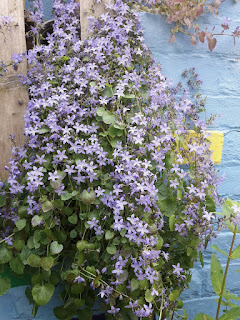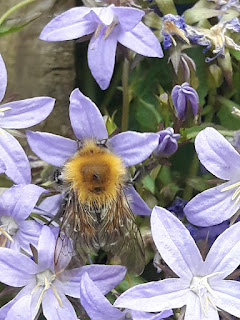After an hour of watering I sat and watched more bees than I saw on the wildflower meadow at the Eden Project and felt very smug. This, I discover, is probably trailing bellflower, a type of campanula, that covers my walls and is the favourite haunt of the bees. So we had honey bees:
tree bumblebees:
what I think, from Alison at Urban Bees June Guide, is a vestal cuckoo bee (they are more common than other similar species):
I had to keep a close eye on them because the spiders were on the prowl, twice attracted by the nearby vibrations to dart out towards a foraging bee. This huge one (meaning probably female) living by the insect hotel:
and this smaller red one on the dog rose (though they are probably both common garden spiders):
I also saw lots of furrow bees and what I hope might have been a mining bee of some kind. I didn't want to leave him to get my camera but just watched him, not on the flowers but munching the edge of a geranium leaf. I am excited to spend more time watching over the next few weeks and see what new species might visit.
Stay safe. Be kind. Spread some bee love.






It's wonderful to see so many bees, I find bees difficult to identify - buff-tailed and white-tailed are almost interchangeable.
ReplyDeleteOh yes, it drives me crazy that the guides aren't more specific about how to tell similar ones apart. I am opening multiple nature websites and seeing if any have a better description.
ReplyDeleteI don't think I've even heard of furrow bees! As to White Tailed and Buff Tailed, even experts will often not know which specific species an individual is (it's acceptable to record a bee as "Buff / White Tailed Bumblebee" in many official surveys).
ReplyDelete